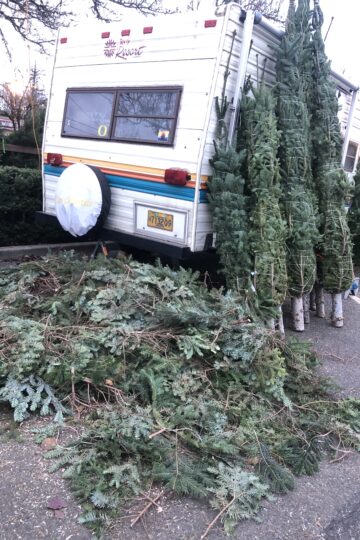Thrift Week -- Day 2, Food Waste

Welcome to day two of Thrift Week. Today's topic is food waste.
With food prices so high, there's simply no excuse for food waste in the home. Regular readers of The Non-Consumer Advocate already know that the issue of food waste is an issue near and dear to my heart. I issued a Waste No Food Challenge last May, and have been continuously working to get my family down to a zero food waste existence. I have learned much in my quest to eradicate food waste, (and still have more to learn) but here's what's worked for us so far:
Be realistic: It's all fine and admirable to fill your grocery cart with tofu and wheat berries, but if that's not how your family actually eats, then it's just a recipe for wastage.
Serve smaller portions: This is especially important with children, but can be a issue with adults as well. It's perfectly okay to have seconds, so make those servings appropriate to each individual.
Stop cooking such huge amounts: Face facts, you're not an army cook. When cooking meals, estimate the amount of leftovers will be produced and use your head. Leftover chicken soup is good once or twice, but after that it's not always so tempting.
Buy smaller amounts: Many foods are less per pound if you buy a larger amount. Unless you have a family of eight, this can be a certain road to food waste. It's okay to buy the actual amount of food you need. I make pizza from scratch and buy the ingredients from the Papa Murphy's up the street. Not only is it cheaper, but I'm able to buy exactly the amount needed.
Only freeze food you'll want to eat again: Many people stash uneaten food in the freezer, only to be forgotten until that revolting smell of freezer burn has taken over. Which brings me to:
Eat the food in your freezer: When your freezer gets overly full of food, it becomes difficult to know the contents until it's too late, which leads to food waste. Go on a spelunking tour of your freezer and start eating what you can. (The thriftiest meal comes from food you've already bought and prepared.)
Think about leftovers: When making a meal, think ahead to what the leftovers will be and how they'll get eaten up. This may as simple as putting meal size portions in containers to take for work lunches, or incorporating ingredients into another meal. For example, I roasted a chicken two nights ago. I then used the extra chicken in some enchiladas the next night. I then ate enchiladas for lunch today. If there's more than you can eat, then freeze the leftovers or share with friends and neighbors.
Plan Your Meals: For many people, this means scheduling the week's menu ahead of time. I don't do this personally, as I loosely follow the pantry principle, (keep a pantry stock of items at all times that can be made into multiple meals.) I usually plan my family's meals a day ahead.
Store your food properly: If your flour gets buggy or your tortillas get crusty, then you have a problem. Stash dry goods in the freezer for 24 hours when first purchased to avoid moths and such, and use tight fitting lids for foods in the refrigerator. I'm a fan of Pyrex dishes with snap-on lids. The glass means I can actually see the contents, and the lid keeps the food fresh. (I've been able to pick up a few key pieces at thrift shops.)
Institute a leftovers night: Often, there's not enough of certain leftovers to create a whole meal, but they can be certainly be warmed up and set out buffet style.
Teach yourself to create new meals from leftovers: I've written about tucking bits and pieces into a pasta salad, but soups and burritos also lend themselves to leftover magic.
A great resource for information about food waste is Jonathan Bloom's terrific website wastedfood.com. You'll find everything you ever wanted to know about issues related to food waste.
Remember, food waste is not just a monetary issue, but also an environmental issue. The tons of rotting food in our landfills create methane gas. So eat up what you can and compost the rest!
What are your methods to avoid food waste? Please share your ideas in the comments section below.
Katy Wolk-Stanley
"Use it up, wear it out, make it do or do without."
Tomorrow on day three of Thrift Week: Don't replace, repair.





Hi 🙂
I love your first tip about being realistic - that's so true!
I've written my tips on my site
http://myzerowaste.com/articles/food/how-to-reduce-food-waste/
and I'm looking forward to reading other people's ideas too. It's a very big issue in our western culture and one which I feel strongly about.
Good luck with reducing your food waste 🙂
I eat mostly vegetarian, but about once every few months, I feel the need for red meat in my diet. Right now I do...must be those Applebees $9.99 steak ads! I bought a small steak for $6.00 that fed 2 of us with leftovers for a steak sandwich today. We had our faux Applebees steak dinner at home complete with baked potato and salad for a fraction of the cost. And it was delicious!
I call leftovers night "Cook's Choice."
If what I serve doesn't appeal to one member of the household, there's always a box of mac and cheese in the cupboard (and that person must prepare it him/herself!) I post the week's menu on the refrigerator.
I make menus about two weeks in advance, since that's how the paychecks come in, and then I can do a one-time big shopping for everything. I used to shop once a month, but we don't have that much storage space here. The freezer gets used a lot. We are considering a small chest freezer to take advantage of meat specials.
Diligence on my part means that buying in bulk is not the same as "food waste". I use a bulk foods store a lot because then I can get flour, rice and so forth at a good price without having to buy fifty pounds at once!
Last week was my no-waste disaster. I'm working my way through my freezer and cupboards in my attempt to use it up and not waste anything. However, I tried several new frugal- type recipes. Two of them were total disasters and I ended up throwing out more food than I usually do.
So I will continue to try new recipes (one of my obsessions), but also stick more with tried and true favorites. My goal now is to simplify meals.
I would like to be a better menu planner, so I'm also struggling with that one.. eating more at home though!
I did a post on that a little while back:
http://www.thefrugalgirl.com/?p=440
Most of the things on my list are similar to yours, except that I also do a lot of baking to use up food(lots of fruits and even some veggies can be used in breads and muffins).
I love to try new recipes as much as the next person. But my dad told me the key is to have 10 recipes that you go to a lot. Usually very simple meals that can be thrown together in less than an hour.
I am only a mid-twenties single gal, so my 10 is still being developed. But so far my recipes are a bean burrito filling, lentil soup, and pasta with pesto (and sometimes shrimp).
To me having 10 recipes will help reduce food waste, because if I make the same things over and over it becomes a nice cycle. I know exactly what I need for the recipes, and eventually if I need to cut them in half then I am familiar enough with the recipe to do it comfortably. 10 dinners should provide enough (but not too much) left overs for lunches, and leaves a few nights free to try new recipes.
I have recently begun stretching my one-week meal plans into two-week meal plans, and shopping once every two weeks. I try to plan meals that require fresh veg closer to the beginning of the cycle, and rely on longer-lasting produce and frozen/canned vegetables toward the end.
Two other little tricks I have recently starting using: I keep a two-litre ice cream bucket in the freezer to hold vegetable peelings and scraps. When it is full, I throw everything in a pot and make vegetable stock. We don't have compost (yet), so we're at least getting one more use out of the scraps before they hit the garbage. 2. I keep a bag in the freezer for bread scraps, which we then chop up and throw in the blender to make breadcrumbs for various recipes. (Probably a logical choice, but for a long time, I was just throwing away the stale, uneaten pieces!)
One final point of interest... our municipality has begun collecting methane gas from the local landfill and using it as a power source.
I try to look at bits of left-over or remaining food in a new way--a piece or two of bread can be cut into squares, mixed with some pineapple bits, an egg, and a dash of milk and sugar, baked in a tiny cassarole dish for 30 minutes or so and turned into a tasty side serving for two that goes well (for the carnivores) with a slice of ham and a steamed veggie. Viola--dinner is ready!
Warmed briefly in the micro, a slice of left-over meatloaf makes a yummy sandwich filling. A couple of carrots can be shredded into muffin batter and served with breakfast, or added to a loaf of banana bread for extra flavor and moistness. Left-over rice can be stir-fried with other left-over tidbits and with a dash of soy or other favorite sauce re-purposed into a new dish.
Got 1/2 a can of stewed tomatoes and a couple of mushrooms hanging around? How about adding a couple of other ingredients and putting together a homemade pizza, or a baked lasagna-type dish, or spagetti, or??
Sometimes I just open my fridge door and let a left-over food item and my imagination lead me to dinner--the important thing is to not wait until the last minute, and also to have some fun with it!